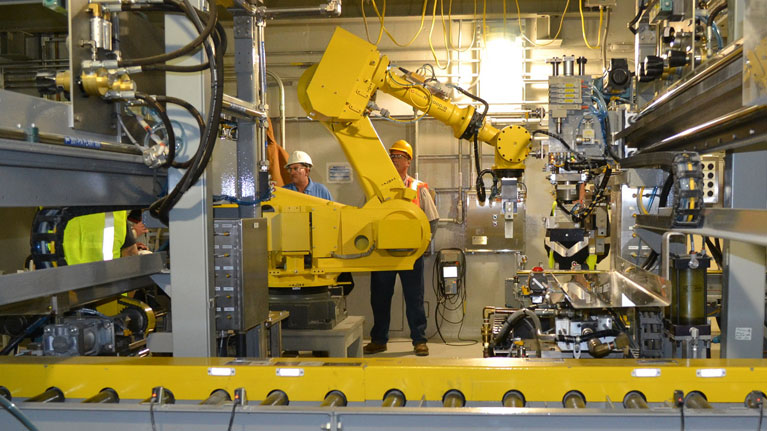The ILO’s World Employment and Social Outlook 2017: Sustainable Enterprises and Jobs, released earlier this month shows innovative companies tend to be more productive, create more jobs and employ more skilled and female workers. ILO News discussed some of these findings with Marva Corley-Coulibaly, lead author of the report.
ILO News: The WESO 2017 report claims that innovation is a major source of competitiveness for enterprises, as well as a key driver of sustained growth and development. What about job creation? Does innovation create or destroy jobs?
There are no simple answers to this question which has been at the core of most discussions around the future of work with the prospect of what some people called a “jobless future”. Clearly, a better understanding of how innovation affects jobs, workers and firms is essential to provide better policy solutions, and our report provides elements of replies.
Previous research already shows that over the long term, technological progress has created more employment that it has destroyed. However, in recent years, in some regions (for example transition and MENA economies) considerable job losses were recorded in non-innovative low-technology firms, highlighting the risk of job loss among low-skilled workers in the manufacturing sector. Obviously, the pace and scale of technological changes have amplified fears for those workers. On the contrary, our report points out that innovative firms tend to create more jobs, employ more workers, in particularly, skilled and female workers, and be more productive.

ILO News: What about the quality of jobs that are being created?
There is certainly some concern in that area. The fact is that both the labour market benefits and social benefits of innovation are not evenly distributed. In some cases, innovation has led to more intense use of temporary workers, especially among female workers. For example, firms implementing product and process innovation tend to employ more temporary workers than non-innovators by over 75 per cent.
While some argue that this shows a need for more flexibility in firms that are likely to innovate, there are also concerns regarding the quality of such jobs, especially in terms of social protection coverage, occupational health and safety, training, among others. Less secure types of working relationship can also lead to possible effects on income inequality. Also, temporary workers are rarely offered training. This might not only prevent them from improving their skills but it might also affect innovation itself in the long term.
ILO News: The report says there are other factors than just research and development that can determine successful innovation. What are the other main drivers?
Indeed, while research and development (R&D) is an important driver of innovation, there are other factors that are relevant. They include public funding, external acquisition of technologies and on-the-job training. Firms may decide to acquire the knowledge externally if they do not have the capacity to create it in-house, and this plays an important role in introducing innovation, especially in developing countries.
Moreover, the report shows that tailored skills obtained through training within the firm are essential, while the impact of formal education is more limited. This may also point to the presence of skills mismatches, reflecting shortcomings in the education system.
ILO News: What are the characteristics of firms that innovate?
Although, some argue that large firms are more likely to innovate because they benefit from economies of scale our research shows that size (as well as age) have a limited link to firm innovation. Smaller firms might innovate more because they are free from the burden of bureaucracy and they are more likely to be willing to take risks. Internal resources as well as easier access to external finance and public subsidies also play a role in innovation.
ILO News: Are there regional differences in the number of innovative firms?
It certainly varies a lot depending on countries and type of innovation. The share of enterprises engaging in at least one type of innovation output is highest in EU-15 countries (51 per cent), followed by Latin America and the Caribbean, at 45 per cent, and the Middle and North Africa region and transition countries at just over 40 per cent. The share of innovation is relatively lower in Africa, but it is still 30 per cent, which suggests that at the micro-level, firms might be innovative even though the income level of the country is low. However, as these figures come from different surveys, comparisons between regions should be interpreted cautiously.
ILO News: What are the policy implications and what does the ILO recommend?
Overall, the report suggests that policies to support firm innovation, are important for employment growth. But, specific policies are also needed to prepare and protect workers and firms effectively for the changing job environment.
The skills needed in the workplace are being rapidly transformed by technological changes and therefore workers require continuous opportunities to acquire up-to-date competencies, regardless of their employment contract. Moreover, consideration should be given to providing flexible and comprehensive social welfare cover to workers whose work arrangements differ from full-time permanent employment.
This also means that governments, workers and employers’ representatives and other stakeholders should reflect together on the type of jobs and skills that will be relevant in the future.
In this regard, the ILO’s Future of Work initiative aims to serve as a platform on which social partners, academics and other stakeholder can have discussions and exchange ideas.
Source: ILO




























